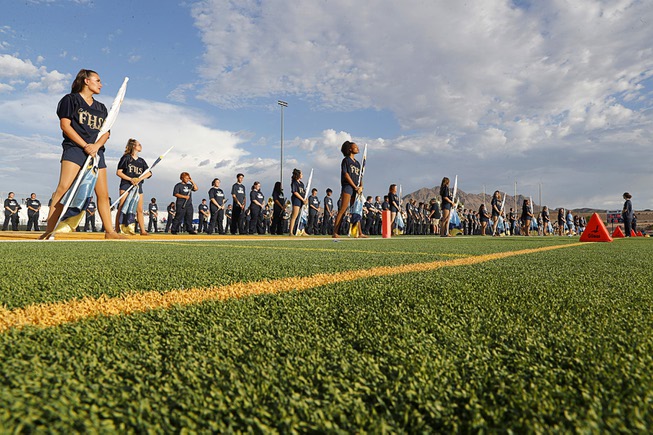
The Foothill Marching Band waits on the field before a high school football game against Centennial at Foothill in Henderson Friday, Sept. 2, 2022. The Clark County School District is saving water by installing artificial turf instead of grass on the school football fields.
Friday, Sept. 9, 2022 | 2 a.m.
Water conservation efforts
The artificial turf football field at Liberty High School that was installed two years ago looks much better than the grass it replaced.
The old layout was nothing but grass patches and dirt by the end of each season. Wear and tear from play after play, combined with watering restrictions cut short any attempt at the grass recovering during the season.
For water conservation officials, the aesthetics of the changeover are secondary. Paramount in their minds was that the artificial turf saved more than a million gallons of water in one summer alone.
When considering Liberty was one of 29 schools where the grass was ripped out in favor of turf, the water savings districtwide is dramatic.
The long-term drought is continually shrinking Lake Mead to dramatic lows, but CCSD was responding long before this summer’s announcement that Nevada will lose 8% of its federal water allotment from the Colorado River next year.
The new football fields, which have been in place for about a year and a half, are among the district’s several waterwise campaigns, and by themselves will save an estimated 135 million gallons of water per year, said Patrick Watson, a conservation services administrator at the Southern Nevada Water Authority who works closely with the schools.
CCSD ripped out more than 2.4 million square feet of grass on football fields over the 2020-21 school year and replaced it with turf installed by the same company that did the synthetic surface used for UNLV’s games at Allegiant Stadium.
Mark Campbell, director of sustainability, energy and environmental services for CCSD’s facilities department, said, “Anecdotally, I have yet to hear a negative word about the football fields.”
He says he checks in incrementally on schools to see how the upgrades are bearing fruit. At Liberty, home to one of the best high school football programs in Nevada, the turf saved 1.5 million gallons of water just during the two-month break in summer 2021, Liberty’s first since receiving its new field.
Rich Muraco, Liberty’s athletic director and football coach, said the crumbled coconut shells used as “organic fill” just beneath the synthetic green grass blades hold humidity better, and thus have better cooling properties than rubber pellets that can also be used for turf fill — and help the surface feel like natural grass, which springy rubber fill does not.
His Patriots squad loves the new turf. It provides a sharper, more accurate backdrop for watching film of opposing teams to study their plays. And it holds up.
“A lot of times our fields were in terrible shape because of the lack of water that they were getting, and the wear and tear that they took,” Muraco said. “By the end of the season the district would stop watering altogether and we were basically playing on dead grass. Some years it was almost like playing on a beach surface.”
Natural grass needs about 73 gallons of water per square foot, per year, to stay alive in Southern Nevada’s climate, Watson said. Each square foot of synthetic turf will use 55 gallons of water — all fields are outfitted with a few sprinkler heads so district staff can occasionally rinse them off and hydrate the fill — and that’s an inflated estimate. Watson said the water authority used the 55-gallon rule of thumb for drought-tolerant decorative landscaping, but CCSD should water the fields less than they would ornamental landscaping.
Watson said CCSD initially planned to only convert a few fields, but he said he talked them into swapping out the field at every high school that had natural grass (a few already had synthetic). As an incentive, the water authority rebated CCSD about $7.4 million through the water authority’s Water Smart Landscapes Program.
Campbell said the low-maintenance turf enhanced all user experiences: for saving water, an estimated $1 million a year in utility costs, time and overhead, from seed to landscaping equipment.
“We’re not buying seeds, we’re not buying fertilizer, we’re not buying fuel for carts or mowers,” Campbell said.
CCSD kicked off the replacement project in August 2020 and completed it by April 2021, when schools were largely closed during the height of the coronavirus pandemic. The district funded the $45 million conversions mostly through government service tax revenue set aside for school capital projects, and a little from the district’s capital replacement fund.The fields should last at least 10 years with proper maintenance.
Watson said the water authority was also working with CCSD on upgrading air conditioning systems to keep less of the water from evaporating in the 60 or so cooling towers at buildings around the district.The initiative will save 181 million gallons of water per year, he said. And the district is midway through a five-year plan to remove 4 million square feet of ornamental, “nonplay” grass at schools in favor of drought-friendly decorative landscaping
“They’ve been a great partner for years and years,” Watson said.
